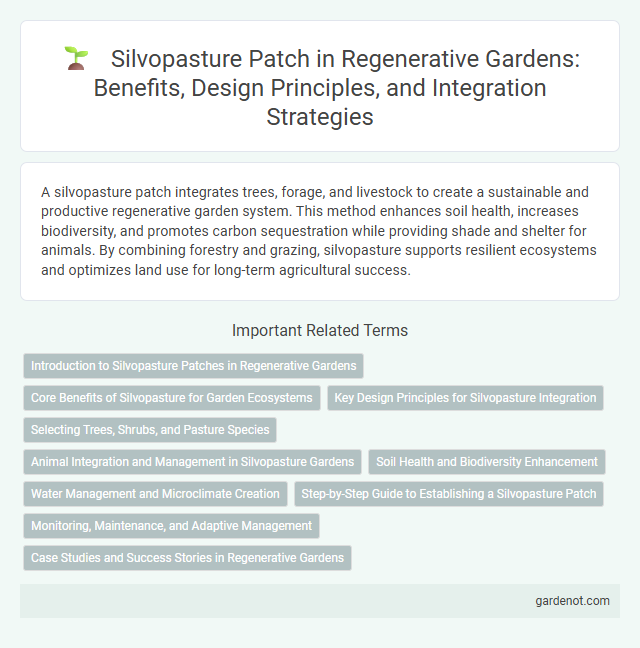A silvopasture patch integrates trees, forage, and livestock to create a sustainable and productive regenerative garden system. This method enhances soil health, increases biodiversity, and promotes carbon sequestration while providing shade and shelter for animals. By combining forestry and grazing, silvopasture supports resilient ecosystems and optimizes land use for long-term agricultural success.
Introduction to Silvopasture Patches in Regenerative Gardens
Silvopasture patches integrate trees, forage plants, and livestock to create a sustainable, multi-layered ecosystem within regenerative gardens. These patches improve soil health, increase biodiversity, and enhance carbon sequestration by combining woody perennials with pasture species. Implementing silvopasture practices optimizes land use and supports resilient agricultural systems in regenerative landscapes.
Core Benefits of Silvopasture for Garden Ecosystems
Silvopasture integrates trees, forage, and livestock to enhance biodiversity and improve soil health in garden ecosystems. This practice promotes nutrient cycling, increases carbon sequestration, and supports microclimate regulation, leading to resilient plant growth and reduced erosion. By creating diverse habitats, silvopasture fosters beneficial insects and wildlife, contributing to balanced pest control and improved ecosystem functionality.
Key Design Principles for Silvopasture Integration
Silvopasture integration emphasizes strategic tree species selection to enhance livestock shade and forage diversity while maintaining soil health through minimal disturbance and rotational grazing methods. Designing optimal tree spacing facilitates balanced sunlight penetration and pasture growth, ensuring ecosystem productivity and animal welfare. Incorporating native woody plants supports biodiversity, carbon sequestration, and long-term farm resilience in regenerative garden systems.
Selecting Trees, Shrubs, and Pasture Species
Choosing trees such as nitrogen-fixing acacias or deep-rooted oaks enhances soil fertility and water retention in silvopasture patches. Incorporating shrubs like blackberries and elderberries provides both habitat diversity and edible yields, supporting wildlife and farm income. Selecting pasture species like clover and ryegrass improves forage quality and boosts carbon sequestration, creating a resilient and productive regenerative garden ecosystem.
Animal Integration and Management in Silvopasture Gardens
Animal integration in silvopasture gardens enhances soil fertility through natural manure deposition, promoting nutrient cycling and reducing synthetic fertilizer dependence. Strategic rotational grazing manages pasture health by preventing overgrazing while encouraging diverse plant growth within tree and shrub layers. Livestock such as cattle, goats, and poultry contribute to weed control, pest management, and biomass reduction, fostering a resilient regenerative ecosystem.
Soil Health and Biodiversity Enhancement
Silvopasture patches integrate trees, forage, and grazing livestock to improve soil health by increasing organic matter and enhancing microbial activity, which boosts nutrient cycling and water retention. Diverse plant species in these systems create habitats for beneficial insects and wildlife, promoting overall biodiversity and ecosystem resilience. This regenerative practice reduces soil erosion and compaction, resulting in healthier, more productive landscapes.
Water Management and Microclimate Creation
Silvopasture patches integrate trees with pastureland to enhance water management through improved soil infiltration and reduced runoff. The diverse vegetation structure promotes microclimate creation by providing shade, moderating temperature extremes, and maintaining soil moisture. This combination supports healthier plant growth, increased biodiversity, and resilient agricultural ecosystems.
Step-by-Step Guide to Establishing a Silvopasture Patch
Establishing a silvopasture patch begins with selecting suitable tree species that provide shade and forage while enhancing soil health, such as nitrogen-fixing trees like black locust or native oaks. Preparing the land involves clearing invasive species, testing soil pH for balanced nutrient availability, and integrating rotational grazing systems to optimize pasture productivity and animal welfare. Implementing protective measures like tree guards and water management ensures long-term sustainability and promotes biodiversity within the regenerative landscape.
Monitoring, Maintenance, and Adaptive Management
Silvopasture patch monitoring involves regular assessment of tree health, soil quality, and livestock impact to ensure ecosystem balance and productivity. Maintenance tasks include pruning, weed control, and rotational grazing to enhance plant growth and prevent overgrazing. Adaptive management integrates data from ongoing evaluations to adjust grazing patterns and vegetation management, optimizing both forage yield and carbon sequestration in the regenerative garden.
Case Studies and Success Stories in Regenerative Gardens
Silvopasture patches in regenerative gardens demonstrate significant improvements in soil health, biodiversity, and livestock productivity, as evidenced by case studies from farms in the southeastern United States. Research from the University of Missouri highlights increased carbon sequestration and enhanced pasture resilience due to integrated tree, forage, and animal systems. Success stories include increased income diversification and ecosystem restoration, proving silvopasture as a scalable model for sustainable agriculture.
Silvopasture patch Infographic

 gardenot.com
gardenot.com